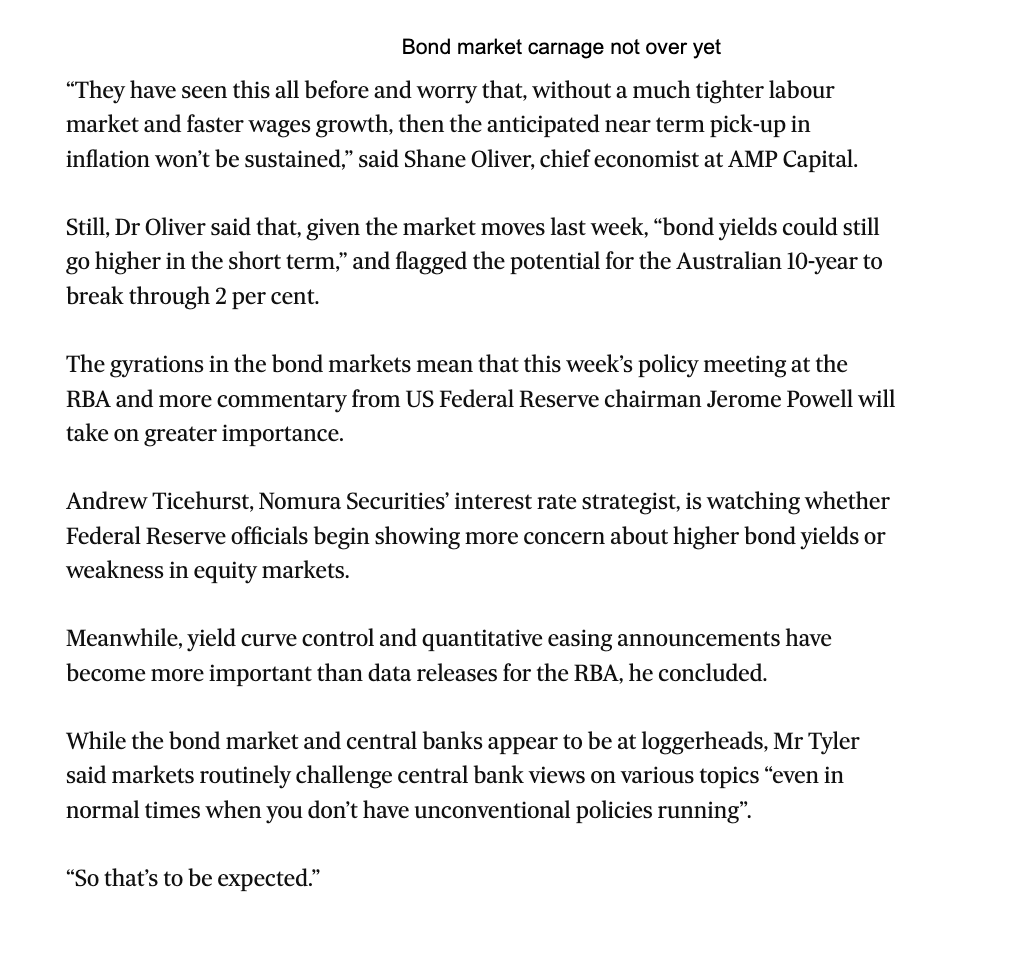Question
In May 2020, an article in the Economist suggested that the rush by Moodys, S&P and Fitch to mark down bonds and loans of all



In May 2020, an article in the Economist suggested that the rush by Moodys, S&P and Fitch to mark down bonds and loans of all types in light of covid-19 was no surprise. The Economist went on to suggest that the downgrade is simply further evidence to confirm the slipping standards of these rating agencies and inability to produce timely and accurate credit ratings.
Several months later in early Dec 2020, Standard & Poors downgraded the long-term credit ratings of New South Wales and Victoria from AAA to AA+ and AA, respectively. When the opposition parties in NSW and Victoria wanted to portray the consequent downgrade as proof positive of their political opponents, they failed to score any political points. Why is that (i.e., failed to score any political points) from the perspectives of Ross Gittins?
Can you please explain this question as I simply do not understand it. If you can explain in a lot of detail that would be really grateful for the help.
The bond market sell-off is not finished, although Monday's cease fire was a welcome respite, as the battle between inflation-vigilant markets and the central banks rages on. Last week, the US 10-year bond yield soared as much as 23 basis points on Thursday alone, and the Australian 10-year shot up 20 basis points to 1.93 per cent. The selling was arrested on Friday on Wall Street when yields reversed course, resulting in Australia's 10-year rate on Monday falling a quarter of a percentage point to 1.64 per cent. It was a very sharp sell-off. Most people had year-end targets that had been met in a couple of weeks so that had people scrambling, said Justin Tyler, director and portfolio manager for interest rates and currency at Daintree Capital. The surge in yields started as a repricing of inflation expectations, after US President Joe Biden's government committed to trillions in stimulus dollars, economic data improved, and vaccination roll-outs progressed at a rapid clip. Australian gov't 10-yr bond yield (%) 2.0 1.8 1.6 1.4 1.2 Jan 21 Feb Mar SOURCE: BLOOMBERG But the market focus then shifted to rising real yields, which tend to be a signal of economic strength. I think that's more important for markets in general where And 10-year US Treasury yields could rise further, the fund manager said. When you look at yields and compare them to various growth proxies, including the ISM, there are a few indicators indicating higher 10-year yields than what we have at the moment, he warned. So it wouldn't surprise me if, after a period of consolidation, Treasuries continue to move higher in, perhaps, a more orderly way. The February ISM manufacturing survey is due out later on Monday and the key US February labour force report is scheduled for release on Friday (12.30am AEDT Saturday). Westpac estimates the US economy created 200,000 jobs last month. Monday's reprieve notwithstanding, volatility could continue amid ongoing discord between the markets and policy makers over the future path of interest rates. Markets have started to price in the chances of interest rate hikes happening sooner rather than later in economies from New Zealand to the US and Australia. But central banks are unmoved by the signs of a coordinated recovery, holding fast to a stance that very accommodative monetary policy is needed to spur growth and achieve full employment. The Reserve Bank of Australia jumped back into the bond market on Monday, buying up $4 billion of government bonds after making significant purchases last week. And the Reserve Bank of New Zealand hinted last week faced with an increasingly sceptical bond market that it may be prepared to take the cash rate negative. The US Federal Reserve has called the rise in bond yields a statement of confidence in the outlook, while committing to keep buying bonds until the economy has made substantial further progress towards its employment and inflation targets. Bond market carnage not over yet They have seen this all before and worry that, without a much tighter labour market and faster wages growth, then the anticipated near term pick-up in inflation won't be sustained, said Shane Oliver, chief economist at AMP Capital. Still, Dr Oliver said that, given the market moves last week, bond yields could still go higher in the short term," and flagged the potential for the Australian 10-year to break through 2 per cent. The gyrations in the bond markets mean that this week's policy meeting at the RBA and more commentary from US Federal Reserve chairman Jerome Powell will take on greater importance. Andrew Ticehurst, Nomura Securities' interest rate strategist, is watching whether Federal Reserve officials begin showing more concern about higher bond yields or weakness in equity markets. Meanwhile, yield curve control and quantitative easing announcements have become more important than data releases for the RBA, he concluded. While the bond market and central banks appear to be at loggerheads, Mr Tyler said markets routinely challenge central bank views on various topics even in normal times when you don't have unconventional policies running. So that's to be expected. The bond market sell-off is not finished, although Monday's cease fire was a welcome respite, as the battle between inflation-vigilant markets and the central banks rages on. Last week, the US 10-year bond yield soared as much as 23 basis points on Thursday alone, and the Australian 10-year shot up 20 basis points to 1.93 per cent. The selling was arrested on Friday on Wall Street when yields reversed course, resulting in Australia's 10-year rate on Monday falling a quarter of a percentage point to 1.64 per cent. It was a very sharp sell-off. Most people had year-end targets that had been met in a couple of weeks so that had people scrambling, said Justin Tyler, director and portfolio manager for interest rates and currency at Daintree Capital. The surge in yields started as a repricing of inflation expectations, after US President Joe Biden's government committed to trillions in stimulus dollars, economic data improved, and vaccination roll-outs progressed at a rapid clip. Australian gov't 10-yr bond yield (%) 2.0 1.8 1.6 1.4 1.2 Jan 21 Feb Mar SOURCE: BLOOMBERG But the market focus then shifted to rising real yields, which tend to be a signal of economic strength. I think that's more important for markets in general where And 10-year US Treasury yields could rise further, the fund manager said. When you look at yields and compare them to various growth proxies, including the ISM, there are a few indicators indicating higher 10-year yields than what we have at the moment, he warned. So it wouldn't surprise me if, after a period of consolidation, Treasuries continue to move higher in, perhaps, a more orderly way. The February ISM manufacturing survey is due out later on Monday and the key US February labour force report is scheduled for release on Friday (12.30am AEDT Saturday). Westpac estimates the US economy created 200,000 jobs last month. Monday's reprieve notwithstanding, volatility could continue amid ongoing discord between the markets and policy makers over the future path of interest rates. Markets have started to price in the chances of interest rate hikes happening sooner rather than later in economies from New Zealand to the US and Australia. But central banks are unmoved by the signs of a coordinated recovery, holding fast to a stance that very accommodative monetary policy is needed to spur growth and achieve full employment. The Reserve Bank of Australia jumped back into the bond market on Monday, buying up $4 billion of government bonds after making significant purchases last week. And the Reserve Bank of New Zealand hinted last week faced with an increasingly sceptical bond market that it may be prepared to take the cash rate negative. The US Federal Reserve has called the rise in bond yields a statement of confidence in the outlook, while committing to keep buying bonds until the economy has made substantial further progress towards its employment and inflation targets. Bond market carnage not over yet They have seen this all before and worry that, without a much tighter labour market and faster wages growth, then the anticipated near term pick-up in inflation won't be sustained, said Shane Oliver, chief economist at AMP Capital. Still, Dr Oliver said that, given the market moves last week, bond yields could still go higher in the short term," and flagged the potential for the Australian 10-year to break through 2 per cent. The gyrations in the bond markets mean that this week's policy meeting at the RBA and more commentary from US Federal Reserve chairman Jerome Powell will take on greater importance. Andrew Ticehurst, Nomura Securities' interest rate strategist, is watching whether Federal Reserve officials begin showing more concern about higher bond yields or weakness in equity markets. Meanwhile, yield curve control and quantitative easing announcements have become more important than data releases for the RBA, he concluded. While the bond market and central banks appear to be at loggerheads, Mr Tyler said markets routinely challenge central bank views on various topics even in normal times when you don't have unconventional policies running. So that's to be expected.Step by Step Solution
There are 3 Steps involved in it
Step: 1

Get Instant Access to Expert-Tailored Solutions
See step-by-step solutions with expert insights and AI powered tools for academic success
Step: 2

Step: 3

Ace Your Homework with AI
Get the answers you need in no time with our AI-driven, step-by-step assistance
Get Started


